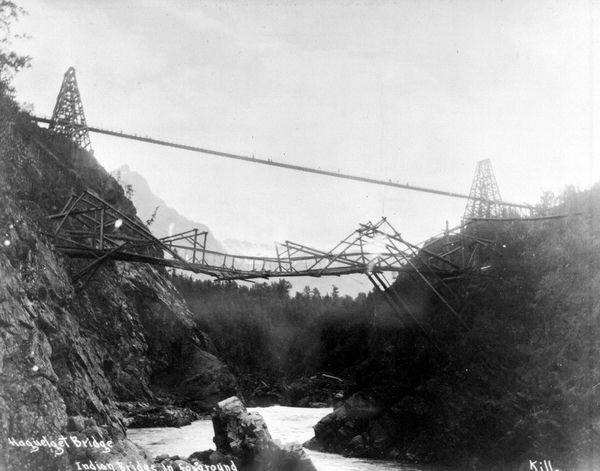The canyons, chasms, and gullies that carve up this province have always made this landscape a challenging one to travel through. Precolonial Indigenous engineers devised some pretty neat ways to span rivers that were often not navigable by boat. Come along for a picture tour of these amazing structures!
Without milled lumber, cement or steel, before giant drills and pile drivers, Indigenous people engineered spans as long as 150 feet across, hanging 50 feet above the swift and turbulent rivers below.
Bridge over the Cranberry (Salmon) River 1905, BC Archives item AA-00168
This bridge over the Cranberry (Salmon) River was made by bending and tying poles with cedar withes (thin, flexible branches), looking a lot like in-stream fish traps that people built with the same materials.
Suskwa River Bridge late 1800s, BC Archives item NA-20442
Some bridge construction will look more familiar, with short cross timbers. This one, on the Suskwa River near Hazelton, was reinforced with telegraph wire in late 1800s, at the request of traders and settlers wanting to take pack animals across.
Most bridges were built using the same ideas behind massive modern suspension bridges: balance and tension. Cantilevered spans fastened with withes, rope and wooden pegs were weighted with rock and log ballast.
Hagwilget Bridge 1872 BC Archives item 06048
Probably the most famous span is the Hagwilget Bridge, which crossed the Bulkley River near Hazelton. A marvel of imagination that continually changed as timbers were replaced, the Hagwilget bridge both impressed and terrified the white men who used it. In 1919 Charles Morison wrote: “it was really a wonderful piece of work! but shaky and calculated to try the nerves of anyone crossing it for the first time”.
Hagwilget Bridge 1890s BC Archives item a_00783
By the 1890s a deck had been added to Hagwilget Bridge. By 1910 it had been reinforced with telegraph wire. By the 1920s settlers tried to replace the whole thing with the new one in the distance. But it was a difficult place to span, and it swayed so much it wasn't that popular!
Second and third bridges at Hagwilget 1920s BC Archives item a_04014
The bridge at Moricetown, 1905, was sturdy enough for livestock to cross, one of the major motivations behind using plank decking.
Bridge at Moricetown 1905 BC Archives item e_08398
There were likely hundreds of these ingenious bridges around BC, constructed and maintained in strategic locations over the millennia. Little more than a few splinters and rotted logs remain, along with these invaluable photos. To learn more, visit the Royal BC Museum’s website (royalbcmuseum.bc.ca/exhibits/living-landscapes/northwest/bridges) or just search BC Archives’ excellent online catalogue of pictures and documents.







